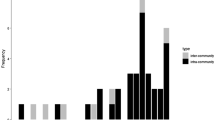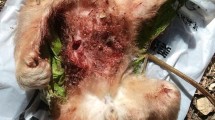Abstract
Infanticide by males has been recorded in four chimpanzee populations, including that in Kibale National Park, Uganda. Some infanticidal attacks occur during inter-community aggression. The sexual selection hypothesis does not easily explain these attacks because they may not directly increase male mating opportunities. However, females in the attackers’ community may benefit by expanding their foraging ranges and thereby improving their reproductive success; thus infanticide may increase male reproductive success indirectly. We report two new cases of infanticide by male chimpanzees at Ngogo, Kibale National Park. Like two previous cases, these occurred during a boundary patrol and were almost certainly between-community infanticides. The patrolling males attacked despite the proximity of males from the victims’ presumed community. This probably explains why, unlike the earlier cases, they did not completely cannibalize their victims. Such attacks seem to be relatively common at Ngogo and infanticide may be an important source of infant mortality in neighboring communities. Our observations cannot resolve questions about the sexual selection hypothesis. However, they are consistent with the range expansion hypothesis: the infanticides occurred during a period of frequent encounters between communities associated with a mast fruiting event, and Ngogo community members greatly increased their use of areas near the attack site during another mast fruiting event one year later. Our observations contribute to growing evidence that lethal intergroup aggression is a common characteristic of wild chimpanzee populations.
Similar content being viewed by others
References
Arcadi, A. C.;Wrangham, R. W. 1999. Infanticide in chimpanzees: review of cases and a new withingroup observation from the Kanyawara study group in Kibale National Park.Primates, 40: 337–351.
Boesch, C.;Boesch-Achermann, H. 2000.The Chimpanzees of the Tai Forest. Oxford Univ. Press, Chicago.
Butynski, T. 1990. Comparative ecology of blue monkeys (Cercopithecus mitis) in high- and low-density subpopulations.Ecol. Monogr., 60: 1–26.
Bygott, D. 1972. Cannibalism among wild chimpanzees.Nature, 238: 410–411.
Goodall, J. 1977. Infant-killing and cannibalism in free-living chimpanzees.Folia Primatol., 28: 259–282.
Goodall, J. 1986.The Chimpanzees of Gombe. Harvard Univ. Press, Cambridge, Massachusetts.
Goodall, J.;Bandora, A.;Bergmann, E.;Busse, C.;Matama, H.;Mpongo, E.;Pierce, A.;Riss, D. 1979. Inter-community interactions in the chimpanzee population in the Gombe National Park. In:The Great Apes,Hamburg,D. A.;McCown,E. R. (eds.), Benjamin-Cummings, Menlo Park, California, pp. 13–53.
Hamai, M.;Nishida, T.;Takasaki, H.;Turner, L. A. 1992. New records of within-group infanticide in wild chimpanzees.Primates, 33: 151–162.
Herbinger, I.;Boesch, C.;Rothe, H. 2001. Territory characteristics among three neighboring chimpanzee communities in the Taï National Park, Côte d’Ivoire.Int. J. Primatol., 22: 143–167.
Hrdy, S. B. 1974. Male-male competition and infanticide among the langurs (Presbytis entellus) of Abu, Rajasthan.Folia Primatol., 22: 19–58.
Hrdy, S. B.;Janson, C.;van Schaik, C. P. 1996. Infanticide: let’s not throw out the baby with the bathwater.Evol. Anthropol., 3: 151–154.
Mitani, J.;Watts, D. P. 1999. Demographic influences on the hunting behavior of chimpanzees.Amer. J. Phys. Anthropol., 109: 439–454.
Newton-Fisher, N. E. 1999. Infant killers of Budongo.Folia Primatol., 70: 167–169.
Nishida, T. 1968. The social group of wild chimpanzees in the Mahale Mountains.Primates, 9: 167–224.
Nishida, T.;Kawanaka, K. 1985. Within-group cannibalism by adult male chimpanzees.Primates, 26: 274–284.
Nishida, T.;Uehara, S.;Nyundo, R. 1979. Predatory behavior among wild chimpanzees of the Mahale Mountains.Primates, 20: 1–20.
Pepper, J.;Mitani, J. C.;Watts, D. P. 1999. General gregariousness and specific partner preference among wild chimpanzees.Int. J. Primatol., 20: 613–632.
Pusey, A. E. 2001. Of genes and apes: chimpanzee social structure and reproduction. In:Tree of Origins,de Waal,F. B. M. (ed.), Harvard Univ. Press, Cambridge, Massachusetts, pp. 1–37.
van Schaik, C. P. 1996. Social evolution in primates: the role of ecological factors and male behaviour.Proc. Br. Acad., 88: 9–31.
Struhsaker, T. T. 1997.Ecology of an African Rain Forest. Univ. Presses of Florica, Gainesville, Florida.
Takahata, Y. 1985. Adult male chimpanzees kill and eat a male newborn infant: newly observed intragroup infanticide in Mahale Mountain National Park, Tanzania.Folia Primatol., 44: 161–170.
Watts, D. P. 1998. Coalitionary mate guarding by male chimpanzees at Ngogo, Kibale National Park, Uganda.Behav. Ecol. Sociobiol., 44: 43–55.
Watts, D. P.;Mitani, J. C. 2000. Infanticide and cannibalism by male chimpanzees at Ngogo, Kibale National Park, Uganda.Primates, 41: 357–364.
Watts, D. P.;Mitani, J. C. 2001. Boundary patrols and intergroup aggression in wild chimpanzees.Behaviour, 138: 299–327.
Williams, J. M. 1999. Female strategies and reasons for territoriality in chimpanzees: lessons from three decades at Gombe. Unpubl. Ph.D. thesis, Univ. of Minnesota, Minnesota.
Wilson, M. I.;Hauser, M. D.;Wrangham, R. W. 2001. Does participation in intergroup conflict depend on numerical assessment, range location, or rank for wild chimpanzees?Anim. Behav., 61: 1203–1216.
Wrangham, R. W. 1999. Evolution of coalitionary killing.Yrbk. Phys. Anthropol., 42: 1–30.
Wrangham, R. W.;Clark-Arcadi, A. P.;Isibirye-Basuta, G. 1992. Female social relationships and social organization of the Kibale Forest chimpanzees. In:Topics in Primatology, Vol. 1: Human Origins,Nishida,T.;McGrew,W. C.;Pickford,M.;de Waal,F. B. M. (eds.), Univ. of Tokyo Press, Tokyo, pp. 81–98.
Wrangham, R. W.;Peterson, D. 1996.Demonic Males. Houghton Mifflin, New York.
Wrangham, R. W.;Smuts, B. B. 1980. Sex differences in the behavioural ecology of chimpanzees in the Gombe National Park, Tanzania.J. Reprod. Fertility (Suppl.), 28: 13–31.
Author information
Authors and Affiliations
About this article
Cite this article
Watts, D.P., Sherrow, H.M. & Mitani, J.C. New cases of inter-community infanticide by Male Chimpanzees at Ngogo, Kibale National Park, Uganda. Primates 43, 263–270 (2002). https://doi.org/10.1007/BF02629601
Received:
Accepted:
Published:
Issue Date:
DOI: https://doi.org/10.1007/BF02629601




